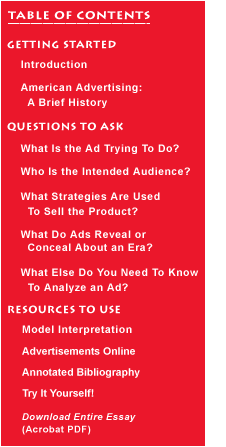talking history | syllabi | students | teachers | puzzle | about us

|
 |
|
As we see the ads, we may also be able to “see through” them to broader social and cultural realities. We can note three contexts for these documents. First of all, they are selling tools and reflect the business needs of the corporations that pay for them. Posing the questions about purposes and methods will give us insights into the role of advertising in business. Second, advertisements are cultural indicators, though distorted ones. Finally, bear in mind that ads emerge from a professional culture of the advertising industry and suggest the aspirations and anxieties of the men (and sometimes women) who create them. To see through ads, we should also look at these creators. For about a century, major national advertisers of brand-named goods and services have employed advertising agencies to plan out their campaigns, write and design the ads, and follow a media strategy to reach targeted buyers with their sales messages. Although advertising men (and women–from early in the 1900s, the industry employed a small but significant number of women in copywriting and art design positions) have long been the butt of cynical jokes about their subservience to advertising clients, advertising took on the trappings of professionalism quickly. As Roland Marchand and others have pointed out, those who created advertisements designed them with the “secondary audience” of their peers in mind. Especially before the 1960s, when agencies diversified ethnically and opened more doors to women, the industry was socially distant from its audiences. Viewing consumers as irrational, ill-informed, and uncultured, advertising agencies often created ads that reflected their own surroundings rather than those of the buyers they wanted to attract. The subculture of the advertising industry is an intense one. In part this follows from the enormous difficulty of judging the effectiveness of advertising. Without clear-cut measures, advertising workers turn to their peers for validation. The fact that agencies can lose accounts (and workers lose jobs) overnight also makes Madison Avenue an anxious place where fads and gurus may shape campaigns. If you are using the web for a comprehensive historical analysis of advertising, you will likely face a significant problem. Ads on the web are usually separated from the editorial matter and the other advertisements that surrounded them. For example, in the Model Interpretation that follows, a researcher examining a print ad in an issue of the Ladies’ Home Journal could compare its themes with the short stories in the same magazine, could judge whether its style differed from other soap and beauty ads in the issue, and could evaluate its impact by considering its size and location in the magazine. Some sites (such as the online collections of Duke University's Digital Scriptorium, Ad Access and Emergence of Advertising in America) provide information about the placement and production of the images they feature, but others present ads without captions about the media they appeared in, their size, the date of their appearance, etc. This seemingly technical problem emphasizes a broader reality that you should bear in mind. While we can glean a lot from the visual and verbal elements in advertisements, advertisements are almost always designed to be part of a media context. The placement of a print ad in a newspaper or magazine, the station, time of day, and program where a commercial appears, the traffic flow past a billboard are all intimately related to the message in the advertisement itself. Understanding advertising thus entails more than just studying advertisements, illuminating as the ads themselves can be. The web is not–at least not yet–an ideal way to put ads in their marketing and media context. In a few cases, however, we can find websites that provide background information for our advertising analysis. The Library of Congress’s American Memory site, “Fifty Years of Coca-Cola Television Advertisements,” offers not only a selection of the commercials in streaming video but an essay on the agencies, advertising strategies, and technologies that Coke has used since the 1950s. The site also gives detailed attention to the making of one of the most famous television commercials ever made, 1971’s “Hilltop,” where young people congregated to sing, “I’d like to buy the world a Coke.” One truth that emerges from the “Hilltop” material is that producing a television commercial for a major campaign is a complex undertaking indeed. An ad agency creative director’s vision that an invitation to share a Coke “was actually a subtle way of saying, ‘Let’s keep each other company for a little while,’” led to a song, “I’d like to buy the world a Coke” and then to grandiose plans for a massive chorus of youth from around the world performing the song on a dramatic hillside. The travails of casting, locating, and filming reveal that commercial production is hardly an exact science. (For example, the female lead was discovered pushing a baby carriage down a street in Rome.) They also indicate the lengths to which major advertisers and their agencies will go to “get it right.”
|
|

|
|

